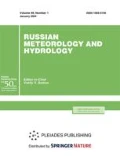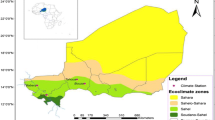Abstract
Uncertainty in predicted precipitation and air temperature are the main sources of the uncertainty in flood forecasting. In this study, the fuzzy set theory is used for assessment of impact that uncertainty in precipitation and air temperature data has on flood forecasting in the Dez basin in southwestern Iran. The precipitation and air temperature were predicted using the Weather Research and Forecasting (WRF) model. The results showed that the uncertainty in peak discharge and flood hydrograph volume was considerably higher due to uncertainty in the precipitation than in air temperature. It was observed that the uncertainty of the peak discharge due to the 10% uncertainty in precipitation and air temperature is 14.8% and 5.6%, respectively. Also, the uncertainty of the flood hydrograph volume due to the 10% uncertainty in precipitation and air temperature is 13.1% and 4.6%, respectively. Therefore, to reduce uncertainty in peak discharge and flood hydrograph volume, precipitation should be predicted more precisely than air temperature.


Similar content being viewed by others
REFERENCES
R. Abrahart, P. E. Kneale, and L. M. See, Neural Networks for Hydrological Modeling (CRC Press, 2004).
M. Azadi, E. Taghizadeh, M. H. Memarian, and L. R. Dmitrieva-Arrago, “Comparing the Results of Precipitation Forecast Based on Mesoscale Models on the Territory of Iran during the Cold Season,” Meteorol. Gidrol., No. 9 (2013) [Russ. Meteorol. Hydrol., No. 9, 38 (2013)].
F. Cannon, R. R. Weihs, L. I. Diaz Isaac, A. Martin, A. Hamidi, A. M. Wilson, and M. Ralph, “An Ensemble-based Evaluation of WRF Precipitation Forecast Uncertainty in California Watersheds,” in AGU Fall Meeting Abstracts, 2018.
E. Gascon, J. L. Sanchez, D. Charalambous, S. Fernandez-Gonzalez, L. Lopez, T. Gareia-Ortega, and A. Merino, “Numerical Diagnosis of a Heavy Snowfall Event in the Center of the Iberian Peninsula,” Atmos. Res., 153 (2015).
S. Hong, J. Dudhia, and S. Chen, “A Revised Approach to Ice Microphysical Processes for the Bulk Parameterization of Clouds and Precipitation,” Mon. Wea. Rev., No. 1, 132 (2004).
N. A. Kalinin, A. L. Vetrov, E. V. Pishchal’nikova, E. M. Sviyazov, and A. N. Shikhov, “Estimating the Accuracy of the Very Heavy Snowfall Forecast in the Urals by the WRF Model,” Meteorol. Gidrol., No. 3 (2016) [Russ. Meteorol. Hydrol., No. 3, 41 (2016)].
N. A. Kalinin, A. L. Vetrov, E. M. Sviyazov, and E. V. Popova, “Studying Intensive Convection in Perm Krai Using the WRF Model,” Meteorol. Gidrol., No. 9 (2013) [Russ. Meteorol. Hydrol., No. 9, 38 (2013)].
T. Lu, T. Yamada, and T. Yamada, “Fundamental Study of Real-time Short-term Rainfall Prediction System in Watershed: Case Study of Kinu Watershed in Japan,” Procedia Engineering, 154 (2016).
J. Mailhot, J. A. Milbrandt, A. Giguere, et al., “An Experimental High-resolution Forecast System during the Vancouver 2010 Winter Olympic and Paralympic Games,” Pure and Appl. Geophys., No. 1–2, 171 (2014).
A. P. Makshtas, K. G. Rubinshtein, V. I. Bychkova, et al., “Preliminary Assessment of the Accuracy of Simulation of Meteorological Parameters in the Arctic Region by the Polar Version of the WRF Model,” Trudy Gidromettsentra Rossii, No. 344 (2010) [in Russian].
S. Maskey, V. Guinot and R. K. Price, “Treatment of Precipitation Uncertainty in Rainfall-Runoff Modelling: A Fuzzy Set Approach,” Adv. in Water Resour., No. 9, 27 (2004).
S. M. Milrad, J. R. Gyakum, K. Lombardo, and E. H. Atallah, “On the Dynamics, Thermodynamics and Forecast Model Evaluation of Two Snow-burst Events in Southern Alberta,” Wea. Forecasting, No. 3, 29 (2014).
J. E. Nash and J. V. Sutcliffe, “River Flow Forecasting through Conceptual Models, Part I: A Discussion of Principles,” J. Hydrol., 10 (1970).
G. S. Rivin, I. A. Rozinkina, A. N. Bagrov, and D. V. Blinov, “The COSMO-Ru7 Mesoscale Model and the Results of Its Operational Testing,” in Informational Collected Papers “The Results of Testing New and Improved Technologies, Models, and Methods of Hydrometeorological Forecasting,” No. 39 (IG-SOTsIN, Moscow, Obninsk, 2012) [in Russian].
K. Schulz and B. Huwe, “Water Flow Modelling in the Unsaturated Zone with Imprecise Parameters Using a Fuzzy Approach,” J. Hydrol., 201 (1997).
M. V. Shiryaev and K. G. Rubinshtein, “Forecast of Meteorological Hazard Categories,” Trudy Gidromettsentra Rossii, No. 347 (2012) [in Russian].
W. C. Skamarock, J. B. Klemp, J. Dudhia, D. O. Gill, D. M. Barker, M. G. Duda, X. Y. Huang, W. Wang, and J. G. Powers, “A Description of the Advanced Research WRF Version 3,” NCAR Tech. Note NCAR/TN-475+STR (2008).
P. K. Srivastava, D. Han, M. A. Rico‐Ramirez, and T. Islam, “Sensitivity and Uncertainty Analysis of Mesoscale Model Downscaled Hydrometeorological Variables for Discharge Prediction,” Hydrol. Proc., No. 15, 28 (2014).
P. K. Srivastava, T. Islam, M. Gupta, G. Petropoulos, and Q. Dai, “WRF Dynamical Downscaling and Bias Correction Schemes for NCEP Estimated Hydrometeorological Variables,” Water Resour. Manag., No. 7, 29 (2015).
P. A. Toropov and A. A. Shestakova, “Quality Assessment of Novorossiysk Bora Simulation by the WRF-ARW Model,” Meteorol. Gidrol., No. 7 (2014) [Russ. Meteorol. Hydrol., No. 7, 39 (2014)].
U.S. Army Corps of Engineers, Hydrologic Modeling System (HEC-HMS). User Manual and Applications Guide: Version 4.3 (Institute for Water Resources, Hydrologic Engineering Center, Davis, CA, 2018).
H. Wang, E. Yu, and S. Yang, “An Exceptionally Heavy Snowfall in Northeast China: Large-scale Circulation Anomalies and Hindcast of the NCAR WRF Model,” Meteorol. Atmos. Phys., No. 1, 113 (2011).
C. J. Willmott, S. M. Robeson, and K. Matsuura, “A Refined Index of Model Performance,” Int. J. Climatol., No. 13, 32 (2012).
R. R. Yager, “A Characterization of the Extension Principle,” Fuzzy Sets and Systems, 18 (1986).
L. A. Zadeh, “The Concept of a Linguistic Variable and Its Application to Approximate Reasoning, Part I,” Inform. Sci., 8 (1975).
Author information
Authors and Affiliations
Corresponding author
Additional information
Russian Text ©The Author(s), 2020, published in Meteorologiya i Gidrologiya, 2020, No. 11, pp. 100-110.
About this article
Cite this article
Mehralipour, M.A., Fathian, H., Nikbakht Shahbazi, A.R. et al. Analysis of Flood Forecast Uncertainty Using the WRF Prediction of Precipitation and Air Temperature. Russ. Meteorol. Hydrol. 45, 797–805 (2020). https://doi.org/10.3103/S1068373920110072
Received:
Revised:
Accepted:
Published:
Issue Date:
DOI: https://doi.org/10.3103/S1068373920110072




